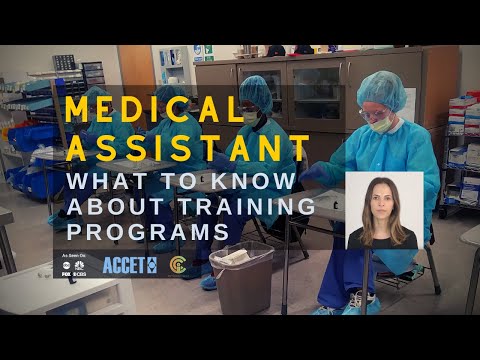What You Need to Know About Medical Assistant Programs
Contents
- 1.What is a medical assistant?
- 2.What do medical assistants do?
- 3.What are the educational requirements for becoming a medical assistant?
- 4.What are the different types of medical assistant programs?
- 5.How long does it take to complete a medical assistant program?
- 6.What is the cost of a medical assistant program?
- 7.What are the benefits of becoming a medical assistant?
- 8.What are the challenges of becoming a medical assistant?
- 9.What are the job prospects for medical assistants?
- 10.What are the best medical assistant programs?
There are many different medical assistant programs out there. But which one is the right for you? Get all the facts before making a decision.
Checkout this video:
1.What is a medical assistant?
A medical assistant is a person who helps a physician with patient care and administrative tasks in an outpatient setting. Medical assistants may perform a variety of duties, such as taking medical histories and recording vital signs, preparing patients for examinations, dispensing medication, and providing instruction to patients about their health care
In order to become a medical assistant, one must complete an accredited Medical Assistant program. These programs typically last between 6 and 18 months and include both classroom and clinical instruction. Upon successful completion of a Medical Assistant program, graduates are eligible to take the Certified Medical Assistant Exam administered by the American Association of Medical Assistants (AAMA).
There are many reasons why someone might choose to become a medical assistant. Medical assistants play an important role in ensuring that patients receive the best possible care. They also enjoy flexible work schedules, competitive salaries, and opportunities for career advancement.
2.What do medical assistants do?
Medical assistants are trained to perform a variety of duties in physicians’ offices, clinics, and other healthcare settings. They typically work alongside other medical staff, such as doctors, nurses, and medical billing and coding specialists.
Common duties for medical assistants include taking and recording patients’ vital signs, such as blood pressure and weight; preparing patients for examination; updating medical records scheduling appointments; handling correspondence; coding and billing insurance claims; and performing general office duties, such as answering phones and ordering supplies.
Medical assistants may also be responsible for giving patients injections or medications, performing minor laboratory tests, removing sutures ( stitches ), applying dressings to wounds, or assisting with minor office surgeries.
3.What are the educational requirements for becoming a medical assistant?
Medical assistants usually need to complete an accredited postsecondary education program to qualify for most positions. Although a high school diploma or equivalent is the minimum educational requirement for most medical assistant positions, many employers prefer or require candidates who have completed a formal training program.1 Some medical assistants, particularly those who have completed formal education programs, become certified.2
Completing a medical assistant program typically takes about 1 year but can take up to 2 years.3 Programs are commonly offered at community colleges, technical schools, vocational schools, and some universities. Many programs offer classroom, laboratory, and clinical components.4 Classroom instruction covers topics such as anatomy and physiology, Medical Terminology pharmacology (the study of drugs), and patient confidentiality.5 Laboratory experiences provide students with opportunities to practice skills such as measuring vital signs (blood pressure and temperature) and taking blood samples.5 Clinical experiences take place in doctors’ offices or clinics where students work with patients under the supervision of a licensed health care professional.4 Some states have licensing requirements for medical assistants. Check with your state’s licensing board for specific requirements in your state.6
4.What are the different types of medical assistant programs?
There are several different types of medical assistant programs, each with their own benefits and drawbacks. The most common type of program is the certificate program, which typically takes around one year to complete. These programs provide students with the basic knowledge and skills necessary to work as a medical assistant, but they may not be suitable for those who wish to pursue a career in the medical field.
Diploma programs are another option, and these typically take two years to complete. These programs offer a more comprehensive education, and they often include an externship component that gives students the opportunity to gain real-world experience. However, diploma programs may not be available in all areas, and they may be more expensive than certificate programs.
Associate’s degree programs in medical assistance are also an option, although they typically take two years to complete as well. These programs provide students with a more well-rounded education, and they often include an externship or clinical component that gives students the opportunity to gain real-world experience. However, associate’s degree programs may not be available in all areas, and they may be more expensive than certificate or diploma programs.
5.How long does it take to complete a medical assistant program?
Most medical assistant programs can be completed in about a year, although some programs may take longer. If you’re attending a full-time program, you can expect to complete your studies in about two semesters. Part-time programs may take up to four semesters to complete.
6.What is the cost of a medical assistant program?
The cost of medical assistant programs can vary depending on the type of program, length of program, and location of the school. The average cost of a medical assistant program is about $3,000, but programs can range from $1,500 to $5,000. Financial aid is available for those who qualify.
7.What are the benefits of becoming a medical assistant?
The role of a medical assistant is varied and important. Medical assistants are key members of the healthcare team, providing clinical and administrative support to physicians and other providers. They are often the first point of contact for patients, and they play a vital role in ensuring that care is coordinated and smooth.
There are many benefits to becoming a medical assistant, including:
-The opportunity to make a difference in people’s lives: Medical assistants work closely with patients and families, providing both care and support.
-A competitive salary: Medical assistants are in high demand, and they earn a competitive salary.
-Flexible working hours: Medical assistants often have the opportunity to work flexible hours, which can be a great benefit for those with families or other commitments.
-Job satisfaction: Medical assistants report high levels of job satisfaction, due in part to the nature of the work and the opportunities to make a difference in people’s lives.
8.What are the challenges of becoming a medical assistant?
Medical assisting is a relatively new profession, which means there is little agreement on what medical assistants should be allowed to do. This can make it difficult to find a program that will give you the skills you need to be successful in your career.
Some medical assistants are allowed to perform very limited tasks, such as taking vital signs and drawing blood. Other medical assistants are allowed to do more advanced tasks, such as administering injections and assisting with minor surgical procedures.
Most medical assistant programs will give you the opportunity to learn both basic and advanced medical assistant skills. However, you may want to consider a program that focuses on one area or the other, depending on your career goals.
9.What are the job prospects for medical assistants?
Medical assistants are in high demand in a variety of healthcare settings. According to the U.S. Bureau of Labor Statistics, employment of medical assistants is expected to grow by 29% from 2019 to 2029, much faster than the average for all occupations.1
In addition to working in physicians’ offices, medical assistants may find work in outpatient care centers, hospitals, and other healthcare facilities. Some medical assistants work independently, providing home health services or traveling to patients’ homes or workplaces to provide care.
10.What are the best medical assistant programs?
There is no one-size-fits-all answer to this question, as the best medical assistant program for you will depend on your specific needs and goals. However, there are some things you should look for in a good medical assistant program, such as accredited coursework, experienced instructors, and opportunities for hands-on training. You can find accredited medical assistant programs at many community colleges and technical schools.







